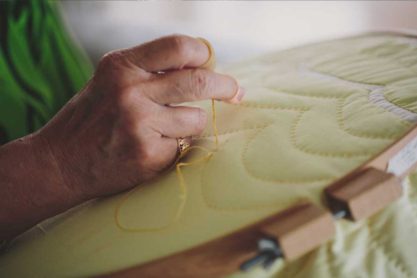Patricia Lei Murray’s Hawaiian quilts have sown stories for more than three decades.
“It all stems from the piko,” Patricia Lei Murray says while gingerly seated on her living room couch, a perch where she has spent countless hours poring over a wooden hoop, weaving memories into Hawaiian quilts. Murray compares the center and starting point of each design to the spiritual piko, or center, of one’s own body. “Piko pondering, shall we say, is really the driving force to make a commitment to each quilt and stay on task. It has to come from your na‘au,” she explains, referencing the gut instinct that often denotes a Hawaiian code of ethics.
Hawaiian quilting features radially symmetric appliqués of native flora and fauna, made from a single cut on folded fabric, that are stitched to a backing to create an artful scene.
Murray first experienced this craft in the 1980s through Kamehameha Schools’ continuing education program, and has dedicated her time to it since, balancing the passion with family and work. Depending on both its size and one’s technique, a single quilt can take years to complete.
“I taught time-management seminars to public and corporate clients for 11 years, so finding time for quilting was never a concern,” Murray says. “My motto is, ʻWhat you value, you make time for.’ I quilt every day. I make time for it. It is my daily meditation.”
Prized Quilts
The septuagenarian describes her prized quilts in the same loving tone that she speaks of her mo‘opuna, or her grandchildren. She can explain, in detail, the name and origin of each finished piece and its components.
When quilting became popularized at the end of the nineteenth century, early Hawaiian quilters were limited to available materials, primarily solid colors and heavy cottons.
Today, a diverse array of fabrics allows Murray to add depth and texture to her quilts, dynamic creations that tell a story through pattern and stitching.
These elements also bear emotional significance to her life, which can be seen as she unveils sentimental keepsakes in her living room: One quilt features a collection of lace doilies from her travels in Paris; another showcases silk ferns, secured with delicate wedding veil tulle.
I would encourage the young people who are interested in any of the cultural arts to be brave, to learn and study, and make it a part of themselves, so that it becomes something they love and are willing to share.

In 2006, Murray reached the pinnacle of her quilting career with a solo exhibit at the La Conner Quilt and Textile Museum in Washington; it was the first time the museum had focused an entire exhibition on Hawaiian quilts by a single artist.
Among the 30 quilts on display was one called “Ku‘u Hae Aloha Mau,” a Hawaiian flag quilt honoring the legacy of Queen Lili‘uokalani. Although other quilters create similar designs bearing the same powerful symbolism, each takes liberties to add personal elements that distinguish his or her own handiwork, and Murray is no exception.
Through each of her flag’s blue stripes, she had stitched, in blue thread, the lyrics to “Ku‘u Pua I Paoakalani,” an added touch so subtle that it is barely visible to the naked eye.
The song details the beauty of the queen’s garden (named Paoakalani), as well as the young man who delivered flowers wrapped in newspaper to ‘Iolani Palace during the queen’s imprisonment. The delivery kept the royal informed of news outside the palace gates during the overthrow of the Hawaiian monarchy.
Importance of Quilting
Murray shares the importance of this quilt with tears in her eyes, recalling the overthrow and the public removal of the Hawaiian flag, a time when women were forced to grieve silently for their lost nation, sewing their pain into quilted flags, which they hung in their homes.
Today, Murray’s flag quilt hangs in the gallery of the Office of Hawaiian Affairs, a symbol of hope and pride for the community.
More than 30 years since she first tried her hand at the craft, Murray remains drawn to the level of devotion required to make a quilt.
She has created more than 125, many of which have been displayed across the country, and has penned two books detailing her award-winning work. She teaches monthly quilting classes from her home in Honolulu, creates commissioned pieces for quilt aficionados, and rescues unfinished quilts for families eager to see the work of their kūpuna completed.
Though millennials have yet to embrace modern-day quilting as meditation, Murray says she hopes the next generation will continue practicing Hawai‘i’s proud art forms: “I would encourage the young people who are interested in any of the cultural arts to be brave, to learn and study, and make it a part of themselves, so that it becomes something they love and are willing to share.”

